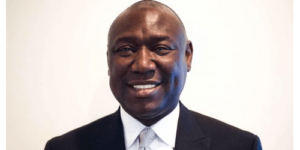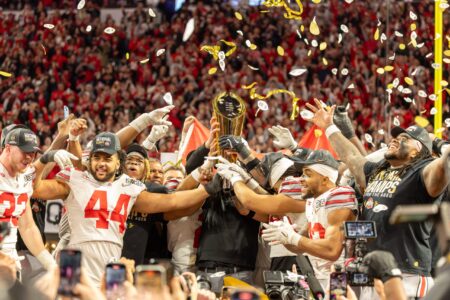By Sam Judy | Dallas Weekly News
Last year, DW reported on the ongoing fight for clean water in Sandbranch. As the issue has been repeatedly dismissed or forgotten by both current District 3 County Commissioner John Wylie Price and Texan politicians at large, political newcomer and candidate Derek Avery is taking part in a new charge to secure funding for infrastructure for the historic freedman’s town. Likened to other Black communities across the country like Flint and Jackson, Sandbranch’s story is one of environmental racism in Dallas County.
In early March, donated water and food were distributed at Wayside Missionary Baptist Church in Sandbranch. The town has not had drinkable water since its well was contaminated over four decades ago.
Volunteers unload food donations for the residents of Sandbranch. Derek Avery and others unloaded pallets of water for residents as well.
Previously holding a population of over 500, numbers dwindled down to 400 in the early 2000’s, and then around 100 by 2010. The vast majority of Sandbranch’s population have fallen off in the past decades, either succumbing to old age or displacement as a result of harsher living conditions. Property taxes in Sandbranch have risen by 2531%.
The distribution comes a week after a community meeting to discuss plans to bring water to the historic Black town with a population of around 40 residents. Now, the community is working with various entities in civil engineering, the nonprofit sector, and the political sphere to ensure that Sandbranch is revitalized.
“This is a human rights issue. However, when you have four or five different groups saying they’re working for Sandbranch, what government alphabet soup is going to give us money? We’ve got to come together here in the community,” a community member says. “Until we get the Water Board, the Water Coalition, everyone to come together, we’re not going to get anything done.”
Healthy skepticism from the community was tangible during the meeting. And as residents spoke, the full weight of the challenges that they face began to take shape in the small Baptist church. Candidate Derek Avery took questions from the community with support from his civil engineer and advisor on the project, Logan Ortiz, to offer a clearer perspective of Sandbranch’s potential future. A major focus of the meeting: dismantling the established notion that there is no tenable solution to Sandbranch’s lack of drinkable water
“Because we’re in a floodplain, we can’t adversely impact the base flood elevation. So, the soil we remove in laying the pipelines would need to be disposed of.” Civil Engineer Logan Ortiz says. “We’d need to identify that soil for any contaminants, as well. […] And if there’s a bond available for a contaminant we find, that’s a green light and a slam dunk.”
Located in Unincorporated Dallas County near Seagoville, the incumbent County Commissioner of District 3 John Wylie Price has offered a singular solution for the residents of Sandbranch. Dallas County offers a buyout of $5000 for properties in the town, but most residents who have been displaced have been left with less than $500 after demolition costs. Regardless, the community has largely rejected this as an answer, pushing for infrastructure that can be typically expected by a taxpaying resident of Dallas County.
Community members spoke at the meeting as well, including Dallas activist Olinka Green, a former Black Panther/New Panther supporting the people of Sandbranch.
“Talking to the people of the community, they said that it has never flooded as long as they’ve been living there,” Green says. She also explained that many properties were placed in a land trust as owners were forced off property after failing to pay expenses to upshore houses due to the area’s classification as a floodplain. Additionally, the community has stated it has been defrauded by organizations claiming to fundraise for Sandbranch.
“And you have a lot of people in the community that have mistrust, because you have organizations that have come into Sandbranch and said they were going to do certain things. There has been money given for the people of Sandbranch, they never saw that money. These people haven’t been treated with respect.”
An area designated as a floodplain is typically under the consequence of environmental racism. As Black communities across the country suffer infrastructure issues due to increased risk of flooding, such as those in areas like Princeville, N.C. or Uniontown, Ala., classifications on the lack of overall viability are usually overstated. Workarounds exist, and specific approaches in civil engineering are present to ensure infrastructure can be provided. The highest hurdle for a town like Sandbranch is evoking sufficient political will.
“I’ve spoken to FEMA, and the biggest myth that’s told is that you can’t build in Sandbranch,” Avery says. “You don’t have to build above the base water, you can build pipelines and work around the environmental factors with different engineering approaches […] A floodplain is a common concept in environmental racism. This is definitely a problem of political will.”
When addressing environmental racism in Sandbranch, David Marquis of Dallas Water Commons gave further context:
“People who suffer the most environmentally are people of color. With a place like Sandbranch, part of the issue is simply the fact that the water most available to them is contaminated water,” Marquis says. “We have to acknowledge there’s been so much illegal dumping of so many different things in Southern Dallas for so long. There’s 63 square miles of unincorporated land in Southeast Dallas. People have dumped everything from tires to pollutants into the Trinity River. And water moves, it travels. We know that’s been a dumping ground for a long time.”
Additionally, many worry that Sandbranch is under threat of gentrification. As climate change has accelerated in recent years, Black communities around the country see increased risk of flooding. While sectors of West Dallas received levies to decrease flood risk, these developments overlapped with gentrification of the area in the last decades. The area’s current status as a floodplain leaving the area subject of restrictive regulation, residents are hoping developing infrastructure will lead to real community revitalization rather than further displacement.
“There’s three real options with regard to the water,” Civil Engineer Logan Ortiz says.“You could create a closed-loop system; we would do an environmental assessment to determine what that contamination is, and we’d find a location here and [establish] a water treatment facility, you’d be recycling the water that you use; you could run to an adjacent aquaphor in a different city, put in a water tower, and pay for water; or you can tap into the city.”
As tapping into city water would be most sensible, residents and members of the Water Board and Water Coalition have pledged support for candidate Derek Avery’s campaign, which names bringing water to the freedmen’s town as a key stance. Avery estimates a total cost of $12.5 million, with $8 million allocated for the project itself and $4.5 million set aside to cover residents’ water bills for 10 years.
The post Solutions for Sandbranch & Deconstructing Environmental Racism first appeared on BlackPressUSA.







